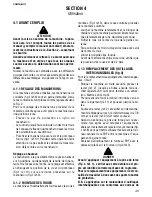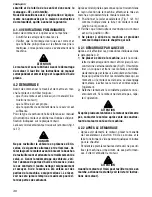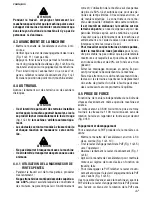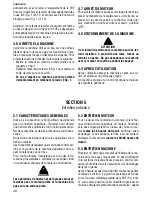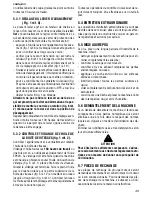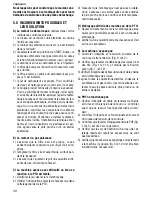
35
ENGLISH
5.8 TROUBLESHOOTING
A) The engine does not start at all: check what fol-
lows:
1) the fuel level reaches at least the half of the fuel
tank;
2) the fuel cap is open (if any);
3) the accelerator is in START position (end of stroke),
the control cable is not released or broken and the
rich mixture control is working («air» - primer);
4) the fuel reaches the carburetor or the injector.
5) the vent on the fuel cap is not clogged;
6) the filter on the carburetor inlet is clean;
7) the carburetor jet is clean. In order to check it,
unscrew it and if dirty, clean it by means of an air
jet;
8) the spark plug makes sparks (gasoline engines).
In order to carry out this check, disassemble the
plug, connect it again to the current cable, lean
the metallic ground part and pull slowly the rope
of the engine recoil starter, as if you wanted to
start it.
If there is no spark between the two electrodes,
try to check the connections between the spark
plug cable and if the current does not arrive yet,
replace the spark plug. If also this gives no re-
sults, the problem concerns the electric system,
and at this point we advice you to contact the clos-
est service center or a specialized repair shop.
B) The engine has no power:
1) check if the air filter is clean; in case it is dirty,
remove the dirt by means of a compressed air jet;
2) replace the filter in case it is dirty with oil, above
all during the transportation;
3) make sure that the correct quantity of gasoline and
air reaches the carburetor.
C) The machine fails to move forwards:
1) Make sure that the transmission belt is in a good
condition and correctly tightened (fig. 6 ref. 2);
2) Make sure that the wheel releasing lever has not
been pulled (fig. 1 ref. 11) and locked with the
relative button (fig. 1 ref. 12);
3) Make sure that the belt stretching and wheel re-
leasing cables are in a good condition.
If the problem has not been resolved even after these
operations have been carried out, you are advised to
contact your nearest assistance center or a special-
ized workshop.
The PTO fails to function
1) Make sure that the belt stretching cable and belt
tension spring are in a good condition. Also make
sure that this spring has not slipped off the idler;
2) make sure that the belt tensioning roller is in a
good condition and that it operates correctly;
3) Check to make sure that the PTO engaging rod
(fig. 1 ref. 5) is pulled towards the operator;
4) Make sure that the bolts that fix the quick cou-
pling shaft for the accessories have not worked
loose;
5) check that the accessory has been correctly
hitched to the machine (the plug fig. 4 ref. 2 must
be securely inserted into the accessory);

























